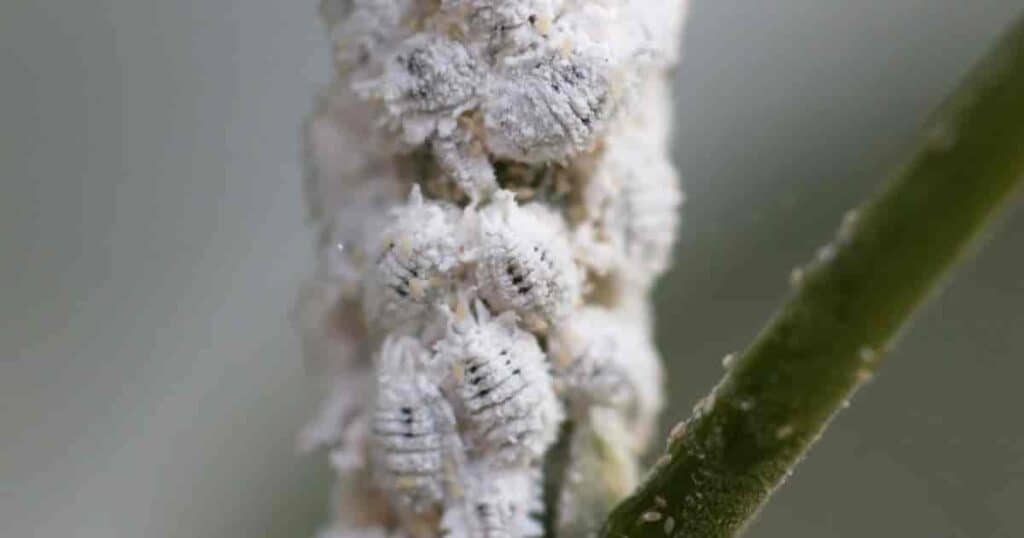Of all the house plant pests out there, perhaps the most frustrating is the mealybug.
Despite there being approximately 270 species in the United States alone, the one most likely to make a host plant of your prized indoor ornamental is the Asian import Planococcus citri.

Better known as the citrus mealybugs, this prolific species targets far more than citrus plants.
It’s considered the most common species of mealybug and targets ornamental plants such as jade plants or spider plants.
The first sign of citrus mealybug populations:
- yellow leaf spots
- premature leaf drop
- the appearance of small cotton-like spots
The bad news is that these prolific pests can spread throughout fig trees, citrus groves, houseplants, and many food crops.
Their powdery wax coating also protects them from most chemical insecticides.
The good news is that many natural remedies can kill these pests if you invest time and effort.
How To Get Rid Of Citrus Mealybug
Due to their resistance to most insecticides, chemical control isn’t viable. Use natural control methods instead.
When dealing with an indoor infestation, use a hands-on technique such as alcohol or neem oil.

Predatory insects and systemic insecticides are best for outdoor mealybug control.
Alcohol (Indoor)
Using isopropyl alcohol (or rubbing alcohol) at strengths below 70% percent kills scale insects, including mealies.
Be sure to test a small area of the plant a day before treatment to make sure there are no allergic or hypersensitive reactions.
Dab a cotton ball or swab in the alcohol and dab every one of the cottony masses directly.
The alcohol will dry the powdery white wax and dehydrate the mealybug, killing it almost instantly.
This method is effective but time-consuming and will need repeating at least once per week to get any hatching eggs.
Natural Enemies (Outdoor)
There are many natural enemies of Pseudococcidae species, many of which you can buy.
The most famous of these is the aptly named mealybug destroyer (Cryptolaemus montrouzieri).
These brown and black beetles resemble ladybugs in shape. They have a voracious appetite for mealybugs, allowing them to eat as many as 200 per week in their larval stage.

The mealybug destroyer isn’t cold-tolerant but can thrive year-round in greenhouses.
Ladybugs and Japanese ladybeetles are also effective mealybug predators.
Meanwhile, two less attractive predators are lacewing larvae and parasitic wasps (Leptomastix dactylopii).
Spiders and some species of small birds eat mealybugs as well.
Be careful not to use a pesticide or insecticide that can also harm your little allies when employing natural enemies.
You may need to use some form of ground pest control to keep ants away. They will often defend mealybugs so they can harvest their honeydew.
Neem Foliar Sprays (Indoor and Outdoor)
Foliar sprays take two weeks to be visibly effective and can be a pain to apply.
Related: How To Use Neem Oil To Kill Mealybugs and Using Neem Oil For Citrus Scale
The good news is there are premade neem sprays available online, and it’s easy to make one yourself.
- Emulsify a gallon of water by adding 1 teaspoon of pure castile soap, Dawn dish soap, or insecticidal soap. This breaks the surface tension, allowing the neem to blend in.
- Next, add four teaspoons of .5% to 3% percent clarified hydrophobic neem oil and mix well.
- Pour this into a spray bottle and test a tiny part of the host plant a day before the first complete treatment.
- Spray every inch of the plant, making sure to get the leaves undersides and the tiny crevasses where leaves or branches connect.
When using outdoors, be sure to apply at dusk or dawn so as not to harm beneficial insects.

The spray dissipates within an hour, leaving no residue (unless you used insecticidal soap).
Reapply every other day for at least fourteen days. Apply every two weeks to healthy plants as a preventative.
Neem Soil Soak (Indoor and Outdoor)
Neem soil soaks are a type of systemic insecticide, meaning they protect the plant from the inside.
The mix is the same as a foliar spray, but use two tablespoons of 100% percent cold-pressed raw neem oil.
Pour 2 to 3 cups of the mixture onto the soil around the plant.
The neem will kill ground pests without affecting earthworms. The plant’s roots then absorb it.
Once inside the plant, a neem soak will remain potent for up to 22 days and poison any pest that pierces the plant’s skin.

It doesn’t directly kill citrus mealybugs but can disrupt their appetite, prevent nymphs from reaching the next growth stage, and cause infertility.
The most significant advantage of a neem soil soak is you can scale up the dosage to protect even large plants.
Since neem is non-toxic to humans and pets, daily use before harvest won’t affect crop yields’ edibility.
You can safely use neem soil soaks on any plant that doesn’t show sensitivity to the neem oil. Reapply every three weeks as a preventative.
Neem oil is one of the best natural biological control measures available to both houseplant lovers and commercial producers.
